This Post May Contain Affiliate Links
In compliance with the FTC guidelines, please assume that some of the links on these posts and sites are affiliate links (Amazon or others) from which I may earn a small compensation/commission from sales of certain items at no extra cost to you from qualifying purchases.
Anytime you see a link that looks like “astore.com, paid link, #ad, #CommissionsEarned or Amazon/Amazon.com/ca,”… it can be assumed that it is an affiliate link.
To learn more, follow the link below.
The Guitar Scale Length Explained
What is Scale Length?
Also called string length, scale is defined on a guitar as the distance between the bridge and the nut or the maximum length of an opened string producing sound or vibrating freely, commonly measured in inches.
How To Measure Scale Length
There are two ways to measure when identifying the scale of your instrument.
- Approximate &
- Accurate
Approximate
It is a term used for measuring scale length from the nut to the bridge on the guitar as a single “approximate or general” measurement. (see Image)
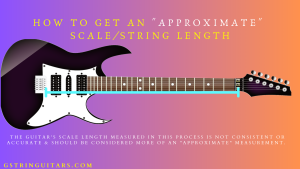
This measurement is not entirely consistent or accurate, for based on which string you measure on the bridge; they are all slightly different scale lengths.
Compensation
This term describes adjustments of each string’s guitar saddle (forward and back) needed to compensate for proper intonation across the entire fingerboard. (See Image)
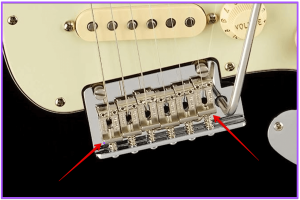
Each string has a different starting point on the saddles resulting in various lengths to compensate for intonation—image courtesy of Amazon.
How Compensation Works
Forward adjustments closer to the nut compensate for flat notes, whereas back adjustments prevent notes from ringing sharp.
What Is Intonation?
It is a term to describe the guitar’s “open” string tuning along with every fretboard note sounding at its correct pitch, as opposed to when the instrument is “out of tune with itself,” where you can tune the open strings and notes are always off-pitch on the fretboard.
Accurate Measurement
To get an accurate scale length, you can approach it in two ways…
- Measure each string’s length and calculate the average – This is time-consuming and not recommended.
- Measuring from the front edge of the nut, where it meets the end of the Fretboard to the middle/centre of the 12 Fret/Octave or where the string contacts the 12th fret when pressed down and then doubling the value – This is common and recommended by most luthiers. (See Image)
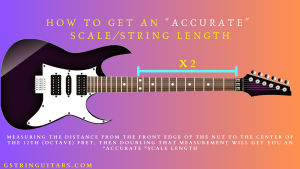
Common Scale lengths
The most common or standard guitar scale length is 24.75″ (628mm), found on most Gibson electric guitars & 25.5″ (648mm), which you will find on numerous Fender models.
The majority of other popular scale lengths will vary around these two standards.
Why Does Scale Length Matter?
Scale length fundamentally contributes to where the overtones or harmonics occur across each string, along with affecting the guitars…
- String Tension & Tones
- What String Gauges Are Used
- String Action &
- Fret Spacing
What Are String Harmonics?
This is where the note harmonics are spaced on the string based on your guitar’s scale & tension.
The longer scale length will have an increased spacing of the string note harmonics, whereas a shorter scale will pack the harmonics closer together.
Scale/String Tension & Tones
String tension determines the range of tones the string can produce at a given tension.
When the scale length increases (25.5″ & up), the tension across the strings must increase in pressure to bring the guitar to the proper pitch.
When the scale length decreases (24.75″ & down), the strings will have less tension requiring less pressure to be brought to pitch.
Bright & Clear Tones
Longer scale lengths (25.5 ” & up) result in bright, crisp & defined overtones and ensure low-end clarity compared to shorter scales which can sound muddier. (i.e. Fender Stratocasters /Telecasters & Baritone guitars with extra strings 7/8/9.)
Pros & Cons of Longer Scales
Pros
- More spaces between frets – For a more comfortable feel, accuracy and precision for larger fretting hands.
- More Tension– For a bright, snappy tone & lighter String gauges resulting in a firmer feel that is not too loose.
- It goes well with lower action setups without fret buzz (More on this later)
- Works well with drop tunings
- More travel distance up & down the fretboards
Cons
- Heavier gauge strings are harder to bend and fret press the notes
- Not the warmest tone
- Wider frets may be more uncomfortable for smaller fretting hand players
Full & Warm Tones
With shorter scale lengths with lower applied string tensions (24.75′ & down), the sound is thicker and warmer, less bright or crisp, with more sustain resulting from the lower tension allowing strings to vibrate more freely. (i.e. Les Pauls, SGs, Flying V, Explorer, SG, ES-335 and other Gibson-inspired guitars. )
Pros & Cons of Shorter Scales
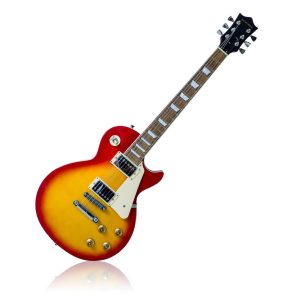 Pros
Pros
- Frets are closer together – More for players with smaller fretting hands
- Strings have less tension – Good for heavier gauge strings and easier for bending, along with fret pressing the notes.
- Creates a warmer and fuller tone
- Less travel distance up & down the Fretboard
- Higher-tuned strings are going to sound better on shorter-scale length instruments.
- Lower string tension makes strings easier to press down
Cons
- Not the brightest or the most articulation in sound
- Can cause fret buzz with lower Action
- Drop tunings may be more problematic
- Smaller fret spacing might be harder to play for larger hands
Best of Both Worlds
PRS 25″ Scale Length
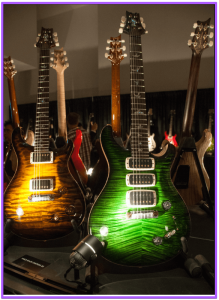
Paul Reed Smith exhibit at NAMM 2014 Author ArtBrom -Image courtesy of Wikimedia and is licensed under the Creative Commons Attribution-Share Alike 2.0 Generic.
PRS-created guitars fill the gap between the two standard scales offering crisp note definitions and fullness to get the best of both worlds.
Pioneering a 25″ (635mm) hybrid scale length, these guitars give a familiar feel and sound while creating something completely new.
The 25″ scale captures the harmonic richness of the Fender electrics and the fullness, warmth, and playability of the Gibson.
Scale/Tension & String Gauges
Since we know that scale length impacts the tension across your guitar strings, how can we easily adjust the tension in our strings using different string gauges.
Rule of Thumb
Generally, use a lighter string gauge to counteract the added tension created by the longer scale length and reduce the string tension on a guitar. (i.e. 25.5″ go with 9-42 gauge strings.)
The opposite is also true…
Guitars with a shorter scale length usually have thicker strings to compensate for the lack of tension. (i.e. 24.75″ goes with 10-46 gauge strings.)
Same String Guage Different Feel
What Happens If You Use The Same Gauge Strings On Two Different Scale Guitars?
The same strings will feel different on guitars with varying lengths of scale. ( i.e. 9-42 guage on the Les Paul as opposed to a Fender Strat) the result is flimsy strings and a change in playability.
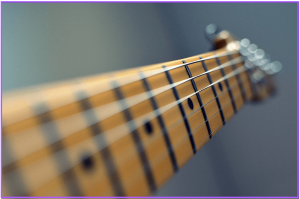
Solution 1
Fitting heavier gauge strings to accommodate the shorter scale (i.e. 10-46) would create more tension, giving the guitar a stiffer and more comfortable feel and control in your fretting and bending of notes.
The opposite is also the case with a long-scale 26.5″ or 27″ baritone guitar fitted with a set of 10-46 gauge strings, which might feel challenging to play. The increase in tension would mean that much more effort would be required to bend its strings.
Solution 2
A thinner set of strings would thus resolve this issue, as their tension would be lower when brought up to pitch.
The tension will decrease each time you move to a lighter string gauge.
With a light enough gauge, you can have precisely the same tension on your longer scale as on your shorter-scale guitar.
Considering scale length and string gauge together is essential.
Players Preference
More than likely, to accommodate the feel of your guitar, you might have already adjusted your strings to compensate by increasing or decreasing the tension using string guages.
No rules exist for choosing string gauges for different scale lengths, but generally, someone who usually plays shorter scales may want to select a heavier string as opposed to if they buy a longer-scale guitar.
This is more of a player’s personal preference.
Scale & String Action
The scale length is essential when setting up your guitar and will directly affect how low you can set your Action.
String height, or the Action of a guitar, is the distance, height or gap of the strings from the fretboard, with a ‘higher action’ setup having a wider gap than a ‘lower setup”. (See Image)
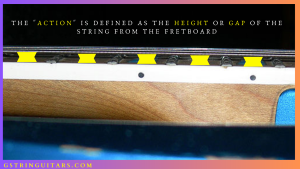
The Image of Ibanez RG 770 String action-Author CLI-Image courtesy of Wikimedia is licensed under the Creative Commons Attribution-Share Alike 4.0 International, 3.0 Unported, 2.5 Generic, 2.0 Generic and 1.0 Generic license.
Scale/Tension/Action & Fret Buzz
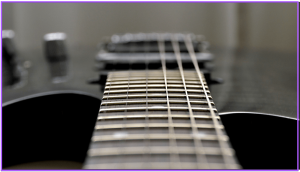
Longer-scale guitars and lighter gauge strings can achieve a low-string action more easily without causing unwanted fret buzz from proper string tension.
Shorter scale lengths and heavier gauge strings could achieve the same low string action, tension and results. But if you go with lighter strings on a shorter scale instrument, generally, you would need a higher action to eliminate fret buzz because of the less tension and the allowance for string vibration.
What Is Fret Buzz?
This is a result caused by strings vibrating against a fret.
Outside of scale/string & tension, some other common areas to look into if you have fret buzz are…
- Uneven frets
- Poor Set up
- A back bowed neck or
- Combination of all the above. (Look to consult your local Luthier for advice or best results.)
Pros & Cons Of Higher Action
Pros
Higher action can improve your sound; Strings that vibrate more freely will reward you with rich, warm tones and excellent sustain.
i.e. Stevie Ray Vaughan
Cons
The drawback is that playing to speed with higher Action and executing advanced techniques are challenging.
Pros & Cons Of Low Action
Pros
The pressure required to perform speed and complicated techniques is diminished and is most preferred by high-level virtuoso players.
i.e. Steve Vai
Cons
Fret buzz can be more prominent, along with ‘Fretting out” and dead zones on the fretboard where the notes die away quickly.
Scale & Fret Spacing
Fret distance/spacing plays a significant part in how a guitar feels and whether or not you find it comfortable to play.
Fretting Hand Size
Finding a guitar with a scale length that suits your hands might be a consideration based on the size of your fretting hand.
Many players with smaller hands will gravitate towards shorter-scale guitars. At the same time, players with larger hands may prefer the less cramped fretboards on longer-scale instruments.
FAQ
Video
What Scale Is Best for You

If a guitar feels uncomfortable, understanding why is a valuable and essential skill to grasp.
Knowing how scale interacts with your string guages, setup, and playing style will make it easier to properly adjust your instrument to get your guitar “Just Right.”
Playing Style
If you’re trying to decide what scale length is right for you, consider your playing style.
- What musical genre are you focused on? (Jazz, Metal, Fusion etc.)
- Do you like to play using a lot of bends & advanced guitar techniques? (i.e. Sweeping, Tapping etc.)
- How do the different gauges of strings “Feel”?
Choosing A Guitar Often Comes Down To What ‘Feels’ Best.
And in many cases, like a new vehicle, the guitar that speaks to you is not the one you thought would work best based on how it “Feels..”
I have both scale-type guitars and like the feel of both standard and shorter-scale guitars. Both have their pros and cons. But I prefer longer standard-scale guitars simply because of the extra fret spaces, play action and lighter gauge strings.
Did You Like This Article?
Check out my post on Scalloped Guitar Fretboards
Also…
Leave your comments in the section below, and if you want me to review a favourite guitar.
As always, stay the course and keep playing.
See you in a couple of weeks for my next post.
Image of Superstrat in Featrue image as well as 1st and 2nd images courtesy of Osckar Espinosa from Pixabay
Fender Stratocaster Image by obBilder from Pixabay
Les paul Image by Jean van der Meulen from Pixabay
Image of the guitar strings courtesy of herry wibisono from Pixabay
Image of Black SuperStrat with Action courtesy of PIRO from Pixabay
Last Image of guitarist silhouette Courtesy of kalhh from Pixabay

Starting A Journey At 7 Years Of Age, The Love For The Guitar Only Became Stronger Going Into My Teens. This Leading To An Exciting Time Of Teaching, Performing, And Recording. Join Me Now As We Can Bring The Love Of This Instrument To Other Musicians Globally.

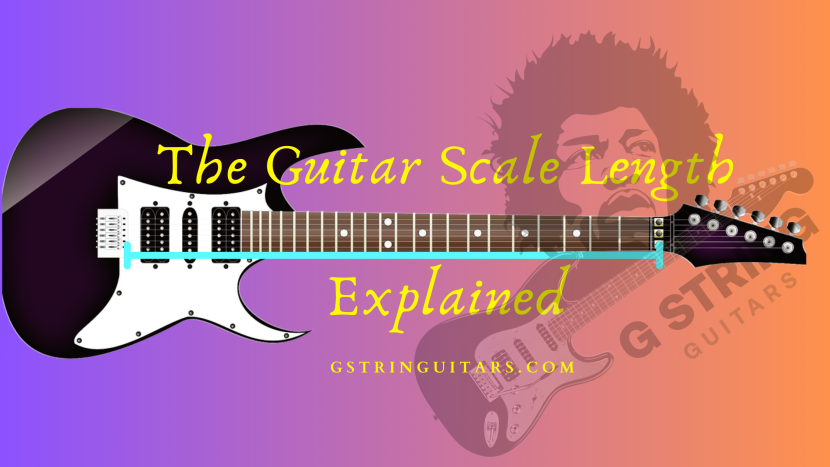
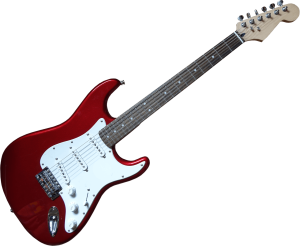





I liked the key points on the guitar scale length! The detailed explanation of how scale length impacts tone, string tension, and playability was particularly enlightening.
I’m curious, how does the scale length affect the sound of acoustic guitars compared to electric ones? That’s something I’ve always wondered about, as I know some people who play the guitar.
Thank you for sharing these insights.
Hello Eric
Great to meet you, and thank you for a visit to our site and for leaving your thoughts.
To answer your question, the concept is the same for both types of instruments.
Again Scale is only one factor in the overall tonal chain & design of the guitar, Electric or acoustic (i.e. neck construction,) but it should be something that should be addressed for your playing style and comfort.
Again thank you for coming by, and please do not hesitate to read more of our content and leave your thoughts.
G string Guitars